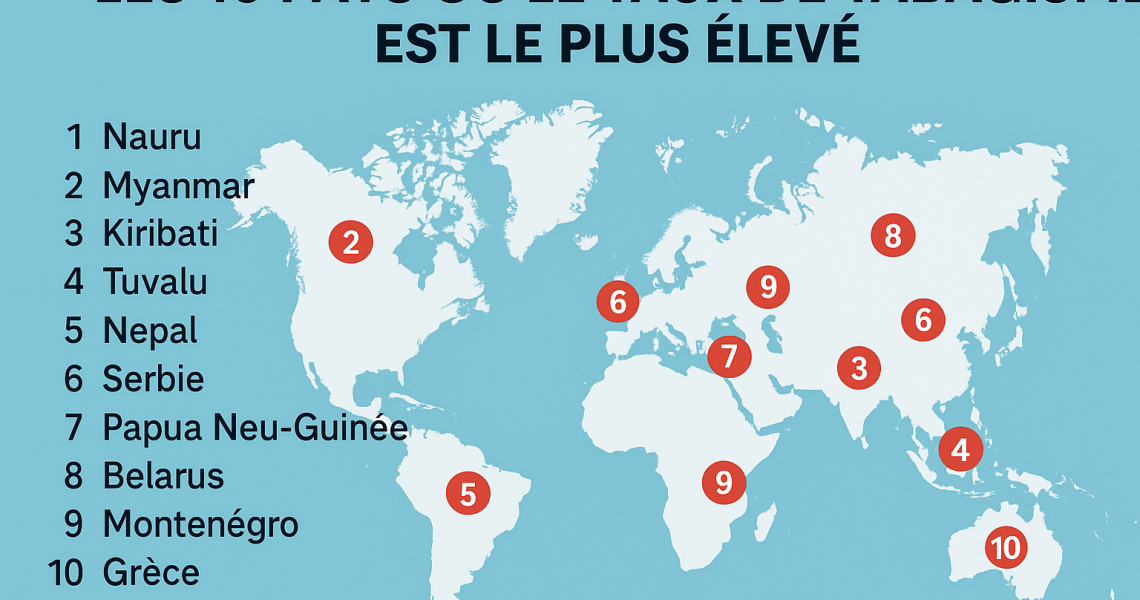
Tobacco remains a massive public health issue. Although the proportion of smokers is falling in many regions, some countries remain heavily affected. Here is the updated
1) Nauru – 49.4
A micro-State in the Pacific and a world record: almost one adult in two smokes. The country combines two mutually reinforcing vulnerabilities: extremely high obesity and massive smoking. The result: compressed life expectancy, explosive cardio-metabolic pathologies and a healthcare system under constant strain.
2) Myanmar – 45.9
Despite a religious framework that discourages alcohol and drugs, cigarettes are an exception: tobacco remains culturally tolerated and very accessible. Prevalence is approaching half of adults, with a marked weighting towards men and a variety of uses (manufactured cigarettes, rolled cigarettes, chewing tobacco).
3) Kiribati – 41.6
Another Pacific nation where the normalization of the smoking gesture remains strong. Kiribati has long held the world’s top spot; the decline since 2014 is real, but the country remains in the red zone, with very marked gender gaps and early starts.
4) Papua New Guinea – 40.7
Four out of ten adults smoke. Overall life expectancy remains low, and logistical challenges (vast territory, access to care, prevention) complicate the dissemination of health messages. Industrial cigarettes coexist with local products, making control policies more difficult.
5) Serbia – 40.1
One of the highest rates in Europe. The
6) Bulgaria – 40.0
EU countries with low average life expectancy and very high smoking prevalence: 4 out of 10 adults still smoke. The issue is not just price: it also concerns access to preventive care, relapse management and the fight against the growing number of women who smoke.
7) East Timor – 39.9
Men account for over 60% of smokers, and information campaigns are hampered by limited literacy andthe strength of social norms. Prevention must involve community relays and simple, repeated, multilingual approaches.
8) Indonesia – 37.8
A demographic giant where prevalence increased between 2000 and 2020. Cheap cigarettes and persistent advertising fuel youth initiation. Tobacco is intertwined with the informal economy; regulation is progressing, but the incentive environment remains powerful.
9) Latvia – 34.7
European paradox: high tobacco use, lower per capita income and reduced life expectancy in the EU. High male smoking rates, relatively early initiation, and the spread of alternative products that do not make traditional cigarettes disappear.
10) Lebanon – 34.4
Tobacco is part of social life (cigarettes, hookahs), and any increase in taxation is accompanied by societal tensions. The economic crisis has also made access to care and withdrawal treatments more complex, with the risk of a switch to cheaper products.
What about France?
19ᵉ in the rankings, with 33.4% of smokers aged 15 and over: despite price hikes and repeated campaigns, cigarettes remain ingrained in the habits of part of the population. The challenge: to maintain prevention while reinforcing access to concrete, rapid and personalized support.
What this Top 10 reveals
- Cultural normalization: the more “commonplace” smoking becomes, the higher the prevalence and the longer it takes to quit.
- Access to care & prevention: where systems are fragile, the dissemination of anti-smoking messages is slow and uneven.
- Gender inequalities: men are still in the majority, but female smoking is on the rise in several countries.
- Economic weight: healthcare costs, absenteeism, lost productivity – the bill is considerable and long-lasting.
From numbers to action: stop smoking now
Statistics show the scale of the problem, but the decision to stop is an individual one. It requires a strategy, a framework and follow-up. The earlier you act, the faster the gains: breath, sleep, energy, skin, heart, wallet. You can make the switch within the first few weeks, provided you have the right support.
Method focus: MyLaserTabac, laser ear reflexology
Turning intentions into results, MyLaserTabac offers a gentle, structured approach:
- Targeted ear stimulation: activation of precise points related to stress, cravings and reward circuits, without needles and without pain.
- Soft laser: non-invasive energy that soothes, regulates tension and reduces cravings during the critical stop phase.
- Personalized session: analysis of habits, triggering moments and contexts (work, commute, meals) to defuse automatisms.
- Advice & follow-up: clear protocols, micro-objectives, relapse management, lifestyle habits (breathing, hydration, sleep) to stabilize benefits.
Our aim is to help you turn the corner, stay the course and return to a cigarette-free life, with human, caring and measurable support.
